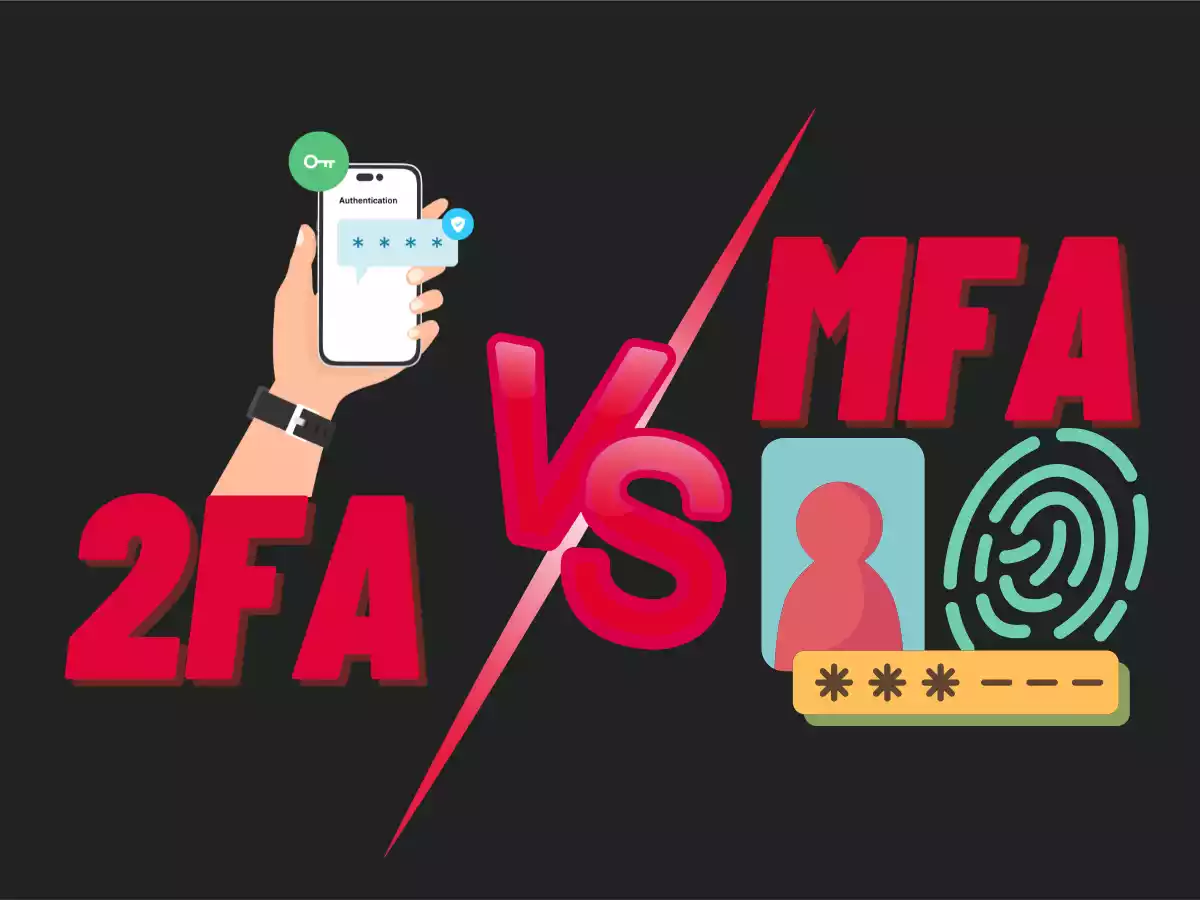Authentication is an essential aspect of online security. It helps to ensure that only authorized individuals have access to sensitive information or accounts. Two-factor authentication (2FA) and multi-factor authentication (MFA) are two of the most common authentication methods used today. While they share similarities, they differ in their level of security and the number of factors required to verify identity. In this blog post, we will explore the differences between 2FA and MFA and discuss when to use each method.
Table of Contents
ToggleTwo-Factor Authentication (2FA)
Two-factor authentication (2FA) is a security process that requires two methods of identification to verify a user’s identity. These methods typically include something the user knows, such as a password, and something the user possesses, such as a smartphone. By requiring two separate forms of authentication, 2FA provides an additional layer of security beyond just a username and password.
Types of 2FA
SMS-based authentication
The user receives a one-time code via text message to their mobile phone, which they then enter as the second factor.
Hardware-based authentication
The user carries a physical device, such as a key fob or USB token, which generates a one-time code that is entered as the second factor.
Biometric authentication
The user’s biometric data, such as a fingerprint or facial recognition, is used as the second factor.
Advantages of 2FA include
- Increased security by requiring an additional form of authentication beyond just a password.
- Easy to implement and use.
- Helps to reduce the risk of account takeover and identity theft.
Disadvantages of 2FA include
Can be inconvenient for users, as they need to have access to their second factor device or method.
SMS-based authentication can be vulnerable to hacking or social engineering attacks.
Some types of 2FA, such as hardware-based authentication, can be expensive to implement.
Examples of 2FA in use include
Online banking platforms that require users to enter a code generated by a security token in addition to their password.
Social media platforms that send a text message with a verification code to the user’s mobile phone when they try to log in from a new device.
Email services that use biometric authentication, such as fingerprint recognition on a smartphone, as a second factor.
Multi-Factor Authentication (MFA)
Multi-factor authentication (MFA) is a security process that requires two or more methods of identification to verify a user’s identity. MFA typically combines something the user knows (such as a password), something the user possesses (such as a smartphone), and something the user is (such as biometric data). By requiring multiple forms of authentication, MFA provides a higher level of security than 2FA or a single-factor authentication method.
Types of MFA
- Two-factor authentication (2FA) – which we’ve already discussed in the previous section.
- Three-factor authentication – which adds a third form of authentication, such as a physical token, to the two factors used in 2FA.
- Risk-based authentication – which uses contextual information, such as the user’s location or behavior, to determine the level of authentication required.
Advantages of MFA include
- Increased security by requiring multiple forms of authentication beyond just a password.
- Provides an additional layer of protection against identity theft and account takeover.
- Can be customized to fit the security needs of a specific organization.
Disadvantages of MFA include
- Can be more complex and difficult to implement than 2FA or single-factor authentication methods.
- May be more expensive to implement and maintain.
- May be more inconvenient for users, as they need to have access to multiple devices or methods.
Examples of MFA in use include
Government agencies that require employees to use a combination of a smart card, PIN, and biometric data to access secure systems.
Cloud-based services that use a combination of SMS-based authentication, mobile app authentication, and biometric data as a third factor to verify user identity.
Health care providers that use risk-based authentication to determine the level of authentication required based on the sensitivity of the patient data being accessed.
Key differences between 2FA and MFA
The key difference between 2FA and MFA is the number of factors required to verify a user’s identity. 2FA requires two separate factors, such as a password and a smartphone, while MFA requires two or more factors, such as a password, a fingerprint, and a physical token.
Another difference is the level of security provided. While both 2FA and MFA offer an additional layer of security beyond a password, MFA provides a higher level of security due to the additional factors required to verify identity.
2FA is often used in situations where a moderate level of security is required, while MFA is typically used in more sensitive environments where a higher level of security is necessary.
When it comes to convenience, 2FA may be less inconvenient for users as it only requires one additional factor, while MFA may be more difficult as it requires multiple factors, which can be time-consuming or difficult to manage for some users.
Finally, the cost and complexity of implementing and maintaining 2FA and MFA can also differ. MFA is generally more expensive and complex to implement than 2FA, as it requires additional hardware, software, and management systems to support the additional factors used for authentication.
In summary, while both 2FA and MFA offer an additional layer of security beyond a password, MFA provides a higher level of security at the cost of increased complexity and potentially more inconvenience for users.
When to use 2FA and when to use MFA
The decision to use 2FA or MFA depends on the level of security required for the system or application being protected. Here are some general guidelines to consider:
Use 2FA when
- A moderate level of security is required, such as for non-sensitive online accounts.
- The cost and complexity of implementing MFA is not justified by the level of risk.
- The user base is not expected to tolerate the inconvenience of using multiple authentication factors.
Use MFA when
- A high level of security is required, such as for sensitive financial data or critical infrastructure systems.
- The cost and complexity of implementing MFA is justified by the level of risk.
- The user base is willing to tolerate the inconvenience of using multiple authentication factors.
It’s worth noting that the decision to use 2FA or MFA should be based on a risk assessment and the specific needs of the system or application being protected. In some cases, a hybrid approach may be appropriate, where certain users or actions require MFA while others only require 2FA or even single-factor authentication.
In summary, 2FA is appropriate for situations where a moderate level of security is required and MFA is appropriate for situations where a higher level of security is necessary. The decision to use either method should be based on a risk assessment and the specific needs of the system or application being protected.
Which one is more secure?
Multi-factor authentication (MFA) is generally considered to be more secure than two-factor authentication (2FA). The reason for this is that MFA requires additional factors beyond just a password and a second factor, which makes it harder for an attacker to gain unauthorized access.
With 2FA, an attacker could potentially guess or obtain a user’s password through social engineering or phishing attacks, and then use the second factor (such as a SMS code) to gain access. However, with MFA, even if an attacker is able to obtain a user’s password, they would still need to bypass additional factors such as a fingerprint scan or a physical token, which makes it much harder to gain access.
That being said, the security of any authentication method depends on how it is implemented and managed. Both 2FA and MFA can be vulnerable to attacks such as phishing, social engineering, or malware, which can compromise the second or additional factors used for authentication.
In summary, while both 2FA and MFA offer an additional layer of security beyond a password, MFA is generally considered to be more secure due to the additional factors required to verify a user’s identity. However, the overall security of any authentication method depends on how it is implemented and managed.
Conclusion
In conclusion, authentication methods such as two-factor authentication (2FA) and multi-factor authentication (MFA) offer an additional layer of security beyond just a password. While 2FA requires two separate factors and MFA requires two or more factors to verify a user’s identity, MFA is generally considered to be more secure due to the additional factors required.
The decision to use 2FA or MFA should be based on a risk assessment and the specific needs of the system or application being protected. 2FA is appropriate for situations where a moderate level of security is required, while MFA is appropriate for situations where a higher level of security is necessary.
Overall, the security of any authentication method depends on how it is implemented and managed. It’s important to implement best practices such as regular password changes, user education on phishing and other attacks, and monitoring for unusual login activity to help ensure the security of systems and applications.




